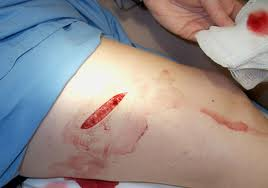Rourke: This post was originally published over at DoomandBloom.net and republished here with permission.
There are many injuries that a medic will face in a survival scenario, and a common and potentially life-threatening one occurs whenever the skin is broken. Your skin is your body’s armor; when it is breached, infectious organisms enter a highway which can transport them to just about any part of the body. Therefore, it makes common sense that you’d want to close that breach to speed healing and lock out infection. Indeed, that’s exactly what happens thousands of times daily in emergency rooms in normal times.
The off-grid medic has a dilemma, however: Most wounds in survival will be dirty, and providing a sterile environment for a surgical procedure is a difficult challenge. You could make the work area as clean as possible, but sterile? Not likely. As such, you should wisely choose what wounds should be closed and what wounds should be left open.
Many medics can’t imagine not closing a tear or cut in the skin (called a “laceration”), but it’s a reasonable way to deal with contaminated wounds in situations where you can’t assure a sterile or even clean, field on which to work. Lacerations that are kept open must be dressed and cleaned regularly until they’re fully healed.
Open wounds heal through a process called “granulation”, where new tissue forms at the base and sides until the defect in the skin is fully healed. Essentially, “from the bottom up”. This tissue is somewhat granular in appearance, hence the name.
“To Close or Not To Close?”
To paraphrase Hamlet, “To close or not to close? That is the question!” To answer this questions, we must examine what our goals are in closing a wound. Among other reasons, you close wounds to:
- Repair the defect in the body’s armor, thus preventing infection in a clean wound.
- Accelerate the healing process. Wound edges that are touching heal faster than those that aren’t.
- Decrease scarring. Scarring is less of an issue in survival, unless the scar would, say, limit the range of motion of a joint in extremity.
A note about bleeding: Although closing a wound may apply pressure to bleeding areas, it is not a substitute for hemorrhage control, also known as “hemostasis” before closure. Consider the application of direct pressure first on the bleeding area, a method that succeeds in many cases. Also, for major blood loss, have tourniquets, hemostatic agents like Celox or Quikclot, and pressure dressings as part of your medical storage.
So what factors come into play when deciding to close a wound or to keep it open? Consider keeping the wound open in these circumstances:
The wound is dirty. Are the circumstances suspicious for contamination? In survival scenarios, the answer is often yes. In austere environments, even WHO (the World Health Organization) agrees that the safest course of action is to keep it open.
Candidate for closure IF clean
Here are some circumstances where wounds should be kept open:
- The wound is infected. Infected wounds have a certain appearance: They are red, swollen (sometimes appearing “shiny”), warm to the touch, and may drain pus.
- The wound is colonized (infected but not yet showing signs). Even the air has bacteria; you can expect a wound to be colonized within 6-8 hours or so.
- There is dead tissue in the wound. This tissue won’t bleed when it is cut and often appears discolored or black. No closure should be performed without removing dead tissue first (a procedure known as “debridement”).
- Puncture wounds, especially from mammalian (including human) bites have lots of bacteria and shouldn’t be closed. Interestingly, snake bites become infected less often than, say, cat or dog bites, but don’t close them either.
- The wound edges are so far apart that closing them would cause undue pressure. This occurs with injuries like “avulsions”, where entire areas of tissue are missing.
wound infection
Here are situations where you should consider closing the wound:
- You’re certain the wound is clean. This usually requires witnessing the injury as it happens.
- The wound has been open less than 6-8 hours.
- The laceration is long or deep enough to penetrate the entire thickness of the skin. A deep wound would allow you to see underlying tissue such as subcutaneous fat.
- The wound is located over a joint. A moving part, such as the knee, will constantly stress a wound and prevent it from closing in by itself.
- The wound gapes open loosely, suggesting that it can be closed without undue pressure on the skin (and won’t close at all without your intervention).
In future articles, we’ll explore wound closure materials, techniques, and theory.
Joe Alton, MD


You can visit his website at DoomandBloom.net and shop his medical preparedness store HERE.









Thanks Rourke- very helpful.I have Dr. Joes books.Happy Fathers Day !!! Arlene
if it is a somewhat minor wound, i let mine bleed for a while to wash out the debris and toxins before bandaging it.